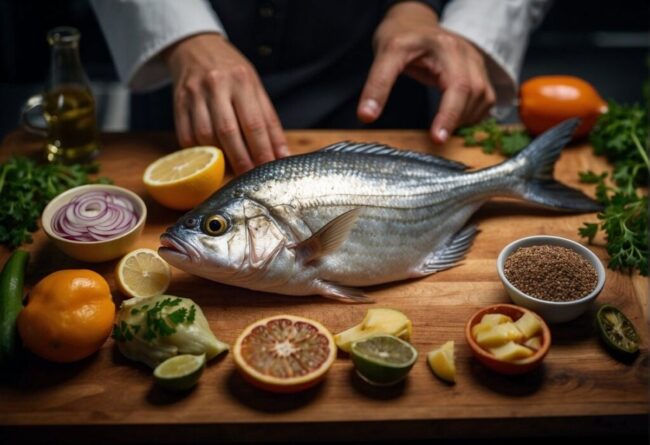Tasty Alternatives to Pompano for Any Dish
Pompano substitutes make sure seafood dishes stay fresh and buttery when this delicate fish isn’t on hand.
Certain choices have the same mild, rich flavor, while others bring a firmer texture.
Baking, grilling, or pan-searing still results in a delicious meal with the right swap.
Selecting a fish that complements the dish ensures a seamless alternative.
What to Know About Pompano
Pompano is a firm, mild-flavored fish popular in grilling, baking, and frying. It is prized for its delicate taste and buttery texture.
Pompano Fish Traits
Pompano fish are known for their exceptional flavor and impressive fighting ability, making them a favorite among anglers.
Their flat bodies and stunning silvery skin catch the eye, reflecting their freshness in the water.
Many consider Florida pompano a culinary gem due to its delicate texture and rich taste.
When cooked, this fish offers an irresistible combination of sweetness and mildness that pairs well with various seasonings.
Anglers often seek out this species not only for the thrill of catching it but also for enjoying it on their dinner plates afterward.
Food Nutrition Facts
Pompano serves as a fantastic addition to any meal with its impressive nutritional profile.
High in protein and healthy fats, this fish supports a balanced diet while being relatively low in calories.
The tender, white flesh possesses a subtle sweetness that seafood enthusiasts truly appreciate.
Pairing well with various seasonings or sides, it can adapt to multiple culinary styles effortlessly.
Enjoy discovering new ways to savor this exquisite fish at your next dinner!
Pompano Replacement Types
Mahi-mahi shines with its firm texture and mild taste, making it perfect for tropical dishes.
Flounder mimics pompano's subtle flavor and flaky consistency beautifully when cooked, while grouper brings a touch of sweetness that complements various preparations.
Red snapper stands out with its nutty profile, providing a hearty alternative that many appreciate.
For those seeking something bolder, tuna offers a distinct flavor that can elevate any meal; golden pompano remains the closest option if you manage to find it in your local market.
Cooking Techniques for Pompano
Cooking techniques for Pompano include grilling, roasting, and pan-searing. Its high oil content makes it flavorful and easy to cook.
Ways to Get Ready
Preparation sets the stage for an exceptional pompano dish.
Descaling is crucial, as it creates a pleasing texture for grilling or presentation.
A clean surface enhances the overall experience, allowing flavors to shine through without any bitterness from scales.
Marinating offers a chance to elevate taste; think about mixing olive oil with zesty lemon juice and fresh herbs for that extra zing.
This step invites delightful nuances that will make every bite memorable, ensuring your meal impresses anyone at your table.
Suggested Cooking Ways
Pompano shines in various cooking methods, each highlighting its distinct flavor.
Grilling offers a quick option, sealing in natural juices while imparting a subtle smokiness.
Baking provides an excellent way to keep the fish moist and tender, especially when wrapped en papillote with herbs and citrus.
Poaching allows for gentle cooking that enhances its delicate profile without overwhelming it with heavy seasonings.
Frying creates a delightful crunch that contrasts beautifully with the fish’s soft texture, delivering satisfaction in every bite.
Things to Think About When Substituting
A delicate flavor is essential; selecting fish with a similar taste prevents any dish from being overpowered.
Texture plays a vital role as well; choose options that maintain the same firmness, allowing for similar cooking techniques.
Local availability matters greatly, so opting for fish commonly found in your area makes it easier to source fresh ingredients.
Sustainability should guide choices too; supporting responsible fishing practices helps protect ocean ecosystems and promotes conservation efforts.
Additional Cooking Tips
Additional cooking tips for Pompano substitutes involve adjusting cooking times and seasoning. Ensuring proper moisture retention helps maintain a tender texture.
Changing Cooking Times
Cooking fish requires attention to detail, especially when selecting substitutes.
Thinner fillets need careful monitoring during cooking to prevent dryness or toughness.
A quick glance at the grill reveals how quickly tilapia can cook compared to thicker options like pompano.
Denser varieties, such as mahi-mahi, call for a bit more patience in the kitchen due to their texture and thickness.
Keeping Taste and Texture
Pompano is celebrated for its delicate texture and sweet flavor, making it a favorite among seafood lovers.
When looking for alternatives, snapper or grouper can provide a similar taste experience.
Choosing fish that stays moist and tender through frying or steaming ensures a satisfying meal.
Techniques like en papillote keep the flavors intact while preventing dryness during cooking.
Where to Buy Substitutes
Where to buy substitutes depends on availability and region. Fresh seafood markets and specialty grocery stores often carry alternatives to Pompano.
Choosing New Options
Freshness plays a crucial role when selecting alternatives to pompano.
Bright, clear eyes and shiny, moist skin indicate high-quality fish.
Mahi-mahi stands out with its firm, pinkish fillets and flaky texture upon cooking.
Red snapper offers a sweet and nutty flavor that complements various dishes beautifully.
Tilapia is an accessible option; it should always have a clean smell and firm flesh to ensure you're getting the best possible quality.
Cost Factors
Choosing a substitute for pompano requires careful consideration of your budget.
Fish prices often change due to factors like availability and demand.
If richness is what you seek, fattier fish will deliver a more robust flavor profile.
Lean options such as tilapia offer milder tastes at typically lower costs, making them budget-friendly choices.
Balancing taste preferences with price ensures that your meal remains satisfying without breaking the bank.


